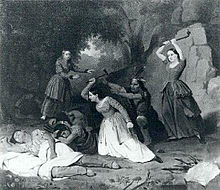Hannah Duston
Hannah Duston (born December 23, 1657 ; died 1736 ) was a white New England settler who was captured by Abenaki Indians in a raid on Haverhill , Massachusetts in 1697, but who axed, scalped and canoeed her abductors in returned home.
Unlike other women abducted by Indians like Mary Rowlandson , Duston herself did not write a report about her time in captivity (a so-called captivity narrative ), but she was asked about her successful escape by Cotton Mather , among others , who wrote her story in a sermon ( Humiliations Followed with Deliverance ; printed Boston 1697) and later included it in his Magnalia Christi Americana (1702). In other contemporary and later reports of Duston's act there are details beyond Cotton's account, the historicity of which can hardly be verified. Accordingly, Haverhill was attacked by Indians on March 15, 1697 as a result of the King William's War and numerous settlers were killed, wounded or captured. Duston watched as her youngest, six-day-old daughter was smashed into a tree and killed by the Indians. She was captured with her wet nurse Mary Neff and forced to march north. After a while they were handed over to an Indian family of twelve who had already held another hostage, 14-year-old Samuel Leonardsen. At dawn on April 30th, as the group camped on an island in the Merrimack River , Duston persuaded their fellow prisoners to try to escape. They beat and scalped the sleeping Indians with axes - two men, two women and seven children. Only one woman in the group of twelve escaped wounded. After her return to Massachusetts, which according to later reports is said to have taken place in an Indian canoe, she was richly rewarded for her act not only by the general assembly of the colony, but also by the governor of Maryland.
Duston's deed soon entered American folklore and was reprinted in numerous partly decorated versions in the 18th and 19th centuries, including as an edifying children's book, and also edited by canonical authors such as John Greenleaf Whittier and Henry David Thoreau . If Duston was portrayed as a courageous heroine in these depictions, Nathaniel Hawthorne underlined the moral dubiousness of her act when he wrote a retelling of the events in 1836 as editor of the American Magazine of Useful and Entertaining Knowledge . Hawthorne referred to Duston as " that awful woman " and " bloody old hag ".
literature
- Robert D. Arner: The Story of Hannah Duston: Cotton Mather to Thoreau . In: American Transcendental Quarterly 18, 1973. pp. 19-23.
- Barbara Cutter: The Female Indian Killer Memorialized: Hannah Duston and the Nineteenth – Century Feminization of American Violence . In: Journal of Women's History 20: 2, 2008. pp. 10-33.
- Teresa A. Toulouse: Hannah Duston's Bodies: Domestic Violence and Colonial Male Identity in Cotton Mather’s Decennium Luctuosum. In: Janet Moore Lindman and Michele Lise Tarter (Eds.): A Center of Wonders: The Body in Early America . Cornell University Press, Ithaca NY 2001. pp. 193-209. ISBN 080143601X .
Web links
- Hannah Duston in the database of Find a Grave (English)
| personal data | |
|---|---|
| SURNAME | Duston, Hannah |
| BRIEF DESCRIPTION | New England settler and kidnap victim |
| DATE OF BIRTH | December 23, 1657 |
| DATE OF DEATH | 1736 |
